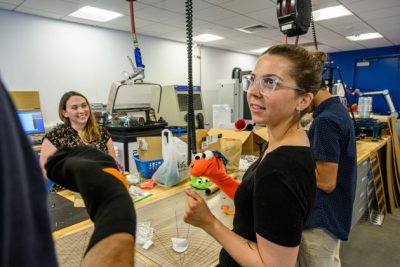The Chronicle (A new interdisciplinary project between Neag School and the Ballard Institute is featured; Sandra Chafouleas is quoted)
Private Investors Stand to Make Millions in Lease of Former St. James Hospital to Newark School District
TapInto.net (Preston Green is interviewed about a school building real estate deal)
Puppets Get the Laser Treatment

Editor’s Note: The “Feel Your Best Self” project, co-created by Neag School’s Sandra Chafouleas, was originally featured in this UConn Today story.
Interdisciplinary collaboration between the Neag School and Ballard Institute goes high tech with the help of the UConn Tech Park, to the benefit of children across the state.
It takes quite a bit of tedious labor to hand-cut enough felt mouths for more than 200 puppet kits. Faced with the prospect of all that precise scissor work, the project leads of the Feel Your Best Self program did the most logical thing – they used lasers.
More specifically, they turned to the experts at the Proof of Concept Center (POCC) at the Innovation Partnership Building (IPB) at UConn Tech Park. In the process, they created an interdisciplinary collaboration between the Ballard Institute & Museum of Puppetry, the Collaboratory on School and Child Health, the Neag School of Education, and the Office of the Vice President for Research – all for the benefit of hundreds of children across the state.
“It’s always cool to collaborate across campus and do something a little different,” says Joseph Luciani, director of POCC.
The Feel Your Best Self program brings together a far-reaching network of UConn faculty, staff, alumni, students, and donors from a number of fields, including educational psychology, puppetry, behavioral health, and finance. It teaches 12 simple strategies on managing emotions to elementary-aged children, including fun practices such as “shake out the yuck” to help calm yourself.
Sandra Chafouleas, the co-director of the UConn Collaboratory of School and Child Health and the Board of Trustees Distinguished Professor in the Neag School of Education, co-created Feel Your Best Self with Emily Wicks, manager of operations and collections at the Ballard Institute. Feel Your Best Self offers free online tools that caregivers of elementary school-aged children can use in classrooms, care centers, and homes throughout the state and country.
The program introduces children to CJ, Mena, and Nico – adorable, lively puppets who star in video lessons that demonstrate the different strategies. The trio of characters bring fun to learning the strategies and are ideal for use with elementary school students. The videos were recorded during the spring and launched online nationwide throughout the summer, complete with simple step cards in English and Spanish as well as a guide to help adults teach each strategy.
Therein created the challenge for Chafouleas and Wicks. To scale use of the puppet-making aspect of Feel Your Best Self, more and more puppet kits were needed. This summer, Feel Your Best Self staff teamed up with the Greater Waterbury YMCA to test adaptations to fit a camp environment. To do so, more than 200 kits were needed quickly, and it was up to the program founders to perform tasks like cutting scores of ping pong balls to create simple puppet-making kits for campers.
“Their puppet friends are bringing fun and joy as students learn the strategies to help them feel their best selves.”
— Professor Sandra Chafouleas
“We didn’t want kids using hot glue guns and scissors,” Wicks says. “We were previously only able to do things on a small scale.”
A chance meeting between Wicks and Luciani through the Mansfield Downtown Partnership introduced an opportunity to make the process much less monotonous and considerably higher tech.
The POCC works with innovators and researchers in a dynamic workspace at the Innovation Partnership Building, serving small and medium-sized businesses with production needs.

Leveraging its expertise in bringing concept to prototype, the POCC has also collaborated with UConn and UConn Health, handling mass 3-D printing of personal protective equipment, beginning with intricate designs dreamed up by inventors. Puppets, on the other hand, were a new endeavor.
Wicks said a “huge lightbulb went off” when she connected with Luciani. She explained the parts that would be needed to fill the kits, such as eyeballs, mouths, and other pre-cut pieces. The POCC took on the job to brainstorm and try out options, and Feel Your Best Self had another partner to its interdisciplinary collaboration.
“They needed to make perfect circles,” Luciani says. “We can do that, and we can do that at scale. Meeting the needs of 200 kids is not such a scary number anymore.”
The collaboration has resulted in many happy campers. The kits were delivered on time for use in the Waterbury YMCA camp. “The stories we are hearing are absolutely heartwarming,” says Chafouleas, who is also the Board of Trustees Distinguished Professor of Educational Psychology at UConn’s Neag School of Education. “The children are very protective of their puppet creations. Their puppet friends are bringing fun and joy as students learn the strategies to help them feel their best selves.”
Wicks says that the partnership with the IPB creates potential for Feel Your Best Self to expand even farther as they continue to test various options. The ultimate goal is to figure out how to mass produce the pieces inexpensively so more children have access to the puppet-making component to the program.
“Interdisciplinary work was a goal of this project from the beginning,” Wicks says. “Technology and puppetry go together hand in hand.”
Puppets Get Laser Treatment
Mirage News (A new partnership with the Neag School and the Ballard Institute is featured; Sandra Chafouleas is quoted)
Back to School Authority: Tips for Adjusting to Middle School
WFSB (Sandra Chafouleas is interviewed about tips with students going back to school)
UConn To Address Need For ‘Skilled Data Scientists’ With New Program
CT Patch (A new interdisciplinary major including the Neag School is featured)
U.S. Ed Secretary to Visit S.C. State
The Times and Democrat (Neag School alumnus and U.S. Secretary of Education Miguel Cardona is featured; Neag School is mentioned)
UConn’s Neag School Set to Offer Four ECE Courses in Education
UConn ECE Magazine (Neag School’s four courses in UConn’s Early College Experience Program is featured)
UConn’s New Multidisciplinary Data Science Master’s Starts this Fall, with Focus on Ethics
UConn Today (Neag School is part of a new multidisciplinary data science master’s degree)
E-STEAM Ahead: CT High Schoolers to Become ‘Eco-Digital’ Storytellers Through Interdisciplinary Grant
UConn Today (Todd Campbell, Neag School are mentioned about an interdisciplinary research project)
